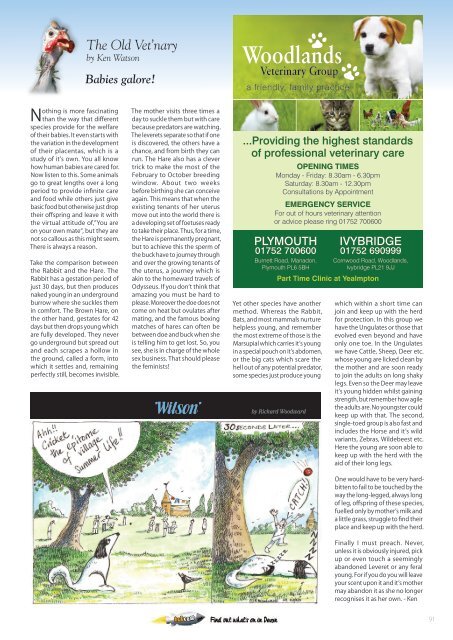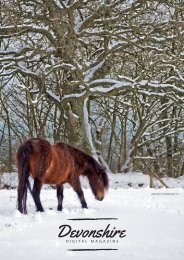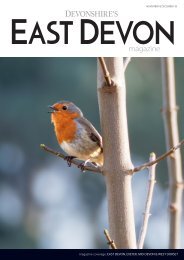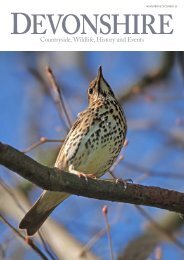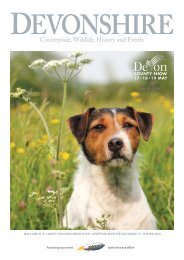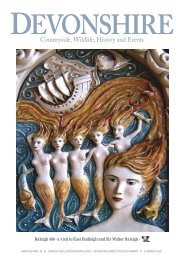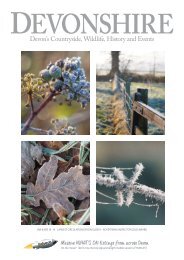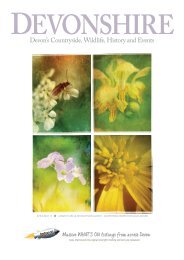Devonshire's East Devon magazine July and August 18
Create successful ePaper yourself
Turn your PDF publications into a flip-book with our unique Google optimized e-Paper software.
The Old Vet’nary<br />
by Ken Watson<br />
Babies galore!<br />
a friendly, family practice<br />
Nothing is more fascinating<br />
than the way that different<br />
species provide for the welfare<br />
of their babies. It even starts with<br />
the variation in the development<br />
of their placentas, which is a<br />
study of it’s own. You all know<br />
how human babies are cared for.<br />
Now listen to this. Some animals<br />
go to great lengths over a long<br />
period to provide infinite care<br />
<strong>and</strong> food while others just give<br />
basic food but otherwise just drop<br />
their offspring <strong>and</strong> leave it with<br />
the virtual attitude of,”You are<br />
on your own mate“, but they are<br />
not so callous as this might seem.<br />
There is always a reason.<br />
Take the comparison between<br />
the Rabbit <strong>and</strong> the Hare. The<br />
Rabbit has a gestation period of<br />
just 30 days, but then produces<br />
naked young in an underground<br />
burrow where she suckles them<br />
in comfort. The Brown Hare, on<br />
the other h<strong>and</strong>, gestates for 42<br />
days but then drops young which<br />
are fully developed. They never<br />
go underground but spread out<br />
<strong>and</strong> each scrapes a hollow in<br />
the ground, called a form, into<br />
which it settles <strong>and</strong>, remaining<br />
perfectly still, becomes invisible.<br />
The mother visits three times a<br />
day to suckle them but with care<br />
because predators are watching.<br />
The leverets separate so that if one<br />
is discovered, the others have a<br />
chance, <strong>and</strong> from birth they can<br />
run. The Hare also has a clever<br />
trick to make the most of the<br />
February to October breeding<br />
window. About two weeks<br />
before birthing she can conceive<br />
again. This means that when the<br />
existing tenants of her uterus<br />
move out into the world there is<br />
a developing set of foetuses ready<br />
to take their place. Thus, for a time,<br />
the Hare is permanently pregnant,<br />
but to achieve this the sperm of<br />
the buck have to journey through<br />
<strong>and</strong> over the growing tenants of<br />
the uterus, a journey which is<br />
akin to the homeward travels of<br />
Odysseus. If you don‘t think that<br />
amazing you must be hard to<br />
please. Moreover the doe does not<br />
come on heat but ovulates after<br />
mating, <strong>and</strong> the famous boxing<br />
matches of hares can often be<br />
between doe <strong>and</strong> buck when she<br />
is telling him to get lost. So, you<br />
see, she is in charge of the whole<br />
sex business. That should please<br />
the feminists!<br />
'Wilson'<br />
...Providing the highest st<strong>and</strong>ards<br />
of professional veterinary care<br />
OPENING TIMES<br />
Monday - Friday: 8.30am - 6.30pm<br />
Saturday: 8.30am - 12.30pm<br />
Consultations by Appointment<br />
EMERGENCY SERVICE<br />
For out of hours veterinary attention<br />
or advice please ring 01752 700600<br />
PLYMOUTH<br />
01752 700600<br />
Burnett Road, Manadon,<br />
Plymouth PL6 5BH<br />
IVYBRIDGE<br />
01752 690999<br />
Cornwood Road, Woodl<strong>and</strong>s,<br />
Ivybridge PL21 9JJ<br />
Part Time Clinic at Yealmpton<br />
Yet other species have another<br />
method. Whereas the Rabbit,<br />
Bats, <strong>and</strong> most mammals nurture<br />
helpless young, <strong>and</strong> remember<br />
the most extreme of those is the<br />
Marsupial which carries it’s young<br />
in a special pouch on it’s abdomen,<br />
or the big cats which scare the<br />
hell out of any potential predator,<br />
some species just produce young<br />
by Richard Woodward<br />
which within a short time can<br />
join <strong>and</strong> keep up with the herd<br />
for protection. In this group we<br />
have the Ungulates or those that<br />
evolved even beyond <strong>and</strong> have<br />
only one toe. In the Ungulates<br />
we have Cattle, Sheep, Deer etc.<br />
whose young are licked clean by<br />
the mother <strong>and</strong> are soon ready<br />
to join the adults on long shaky<br />
legs. Even so the Deer may leave<br />
it’s young hidden whilst gaining<br />
strength, but remember how agile<br />
the adults are. No youngster could<br />
keep up with that. The second,<br />
single-toed group is also fast <strong>and</strong><br />
includes the Horse <strong>and</strong> it’s wild<br />
variants, Zebras, Wildebeest etc.<br />
Here the young are soon able to<br />
keep up with the herd with the<br />
aid of their long legs.<br />
One would have to be very hardbitten<br />
to fail to be touched by the<br />
way the long-legged, always long<br />
of leg, offspring of these species,<br />
fuelled only by mother’s milk <strong>and</strong><br />
a little grass, struggle to find their<br />
place <strong>and</strong> keep up with the herd.<br />
Finally I must preach. Never,<br />
unless it is obviously injured, pick<br />
up or even touch a seemingly<br />
ab<strong>and</strong>oned Leveret or any feral<br />
young. For if you do you will leave<br />
your scent upon it <strong>and</strong> it’s mother<br />
may ab<strong>and</strong>on it as she no longer<br />
recognises it as her own. - Ken<br />
91


